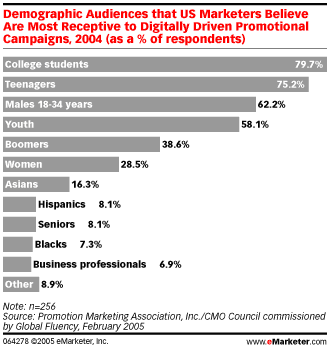Reaching out to a teen audience has always been challenging, but with social media fragmentation, additional efforts must be employed to achieve success in a company’s marketing research activities. The website imediaconnection.com has published “Marketing to the Always-On Teen” which cites a Promotion Marketing Association and CMO Council survey of teens.
Broadband Video
Taking advantage of rising use of broadband, websites are upping their broadband offerings aimed at teens. Viacom’s Nickelodeon launched TurboNick, featuring clips and full-length television episodes along with TV-like ads. Eventually, kids will be able to send videos to friends, rate their favorite videos, and download content. Sister channel MTV offers MTV Overdrive with similar intentions.Advertisers including Kellogg’s Pop-Tarts, Gap and Microsoft have ponied up to reach teens in this new venue. Since many of the ads cannot be skipped, the audience is more easily guaranteed. However, there’s a danger that kids will click away before the content loads if the ad doesn’t appeal to them.
Though real-time video and audio have improved dramatically, the uncertainties of broadband connections mean glitches and pauses and the occasional “buffering” advisory, such as occurred on MTV Overdrive on the day after MTV’s Video Music Awards in August 2005. All of this gives restless teens a chance to turn away to something else.
Immersive Environments
There’s a good reason Viacom forked over an estimated $160 million for Neopets, the immersive game where kids create and take care of virtual pets. Actually, 25 million reasons. The site has attracted a huge audience of dedicated users and has grown to become one of the “stickiest” kids sites online. Viacom sees it as a key part of its growing Internet strategy.Neopets is probably the best known of a group of sites that allow people to interact in a virtual world. Its central “city” of Neopia is teeming with storefronts just aching for a brand name, while the games area offers dozens of games that, with a few tweaks, could easily carry brand names. A few willing marketers have signed on, including McDonald’s, Reebok and, oddly, Disney (perhaps in a deal that predates the Viacom acquisition).
Kellogg’s Pop-Tarts, meanwhile, has found its way to Habbo Hotel, a Finnish-originated site with versions in 16 countries. Habbo received four million unique visitors across all its properties in June 2005, according to Nielsen//NetRatings.
Immersive games seem a perfect antidote to the frenetic, fragmented lives of teens, but marketer-sponsored games must be labeled as advertising, especially for the youngest set of online users. And potential advertisers need to consider that an immersive game environment is not static: There are always new worlds to discover and new people (or pets) to interact with. An advertiser’s role in such games should not be static, either.
Mobile Marketing
The mobile marketing opportunity has been in the “nascent” phase for several years, but it’s gradually picking up steam.According to a 2004 study by Ball State University, 17 percent of teens surveyed said they have received an ad on their mobile phone. Similarly, Enpocket found in a 2005 study that 16 percent of young adults ages 18-24 have seen an advertising message on their mobile phone.
Some companies, such as record label EMI Group for the band Coldplay, are testing ads that beam out to mobile phone users in Heathrow Airport. The ads, triggered by Bluetooth technology, feature video clips and interviews with the musicians, according to an August 2005 article in The Wall Street Journal.
Texting campaigns are picking up steam as well. Frito-Lay’s Doritos featured a text component in its teen-oriented “If Not Now When” campaign. Kellogg in 2004 launched a long-running text messaging campaign that featured a call to action on boxes of Corn Pops and other cereals.
So far, the efforts have been mostly opt-in, given that most people consider mobile phones personal and private. However, the teen audience may be more receptive than others to messaging that doesn’t require them to opt in. This is a group, after all, that is used to being interrupted by phone calls, instant messages and text messages.
Instant Messaging
Like text messaging, instant messaging can be highly personal. But so far, indications are that teens are ripe for IM marketing campaigns.To accompany Procter & Gamble’s launch of Secret Sparkle, a body spray and antiperspirant line aimed at teen girls, the company teamed with AOL to create an IM campaign. So far, according to an August 2005 report in Forbes, girls have downloaded Sparkle-themed buddy icons more than 55,000 times. In addition, a reported one million teens have interacted with a Secret Sparkle “chat bot,” sending a whopping 75 million IMs to the bot.
AOL in August 2005 revamped its instant messaging platform to offer users easier connections to other AOL services, such as blogging tools, mobile applications and more. It recognizes that teens have myriad communications tools at their disposal and that the easier it is to access them at any given moment, the more they are likely to use them.
Movie company Focus Features took a different tack for its fall 2005 release Cry Wolf, launching a multi-player game that pits AOL IM users against each other to find the wolves in sheep’s clothing.
Another strategy, used by marketers ranging from Campbell Soup to Pepsi to Carl’s Jr., is to offer downloads that change the look and feel of the IM application (something Yahoo! Messenger calls “IMVironments”).
Tactics like these appeal to teens’ quickly changing interests and their desire to be on top of what’s hot and what’s not on a given day. They also give teens the ability to personalize their media, something that is very important to them.
Courtesy: imediaconnection.com


